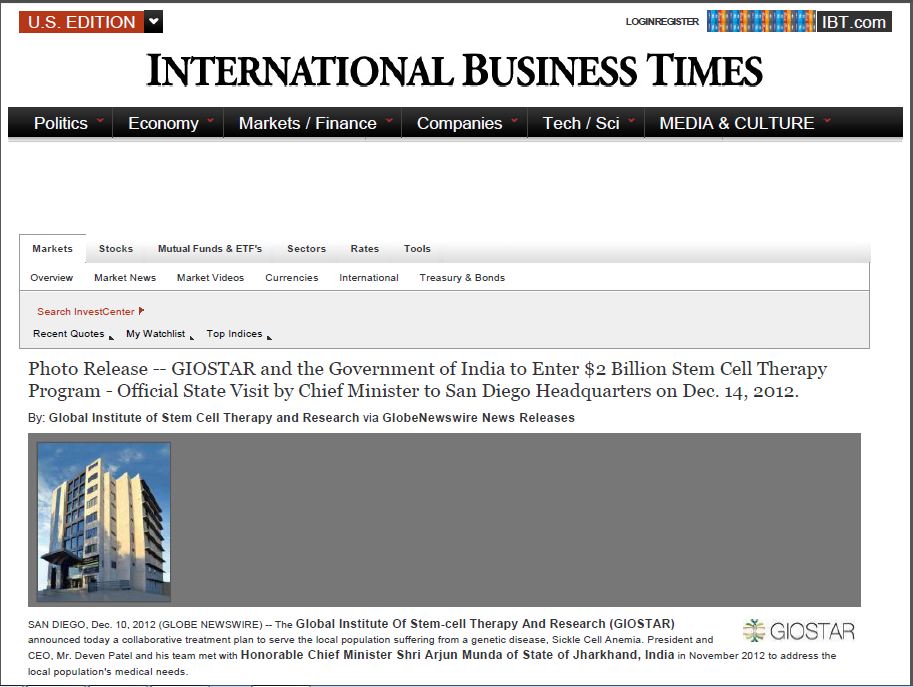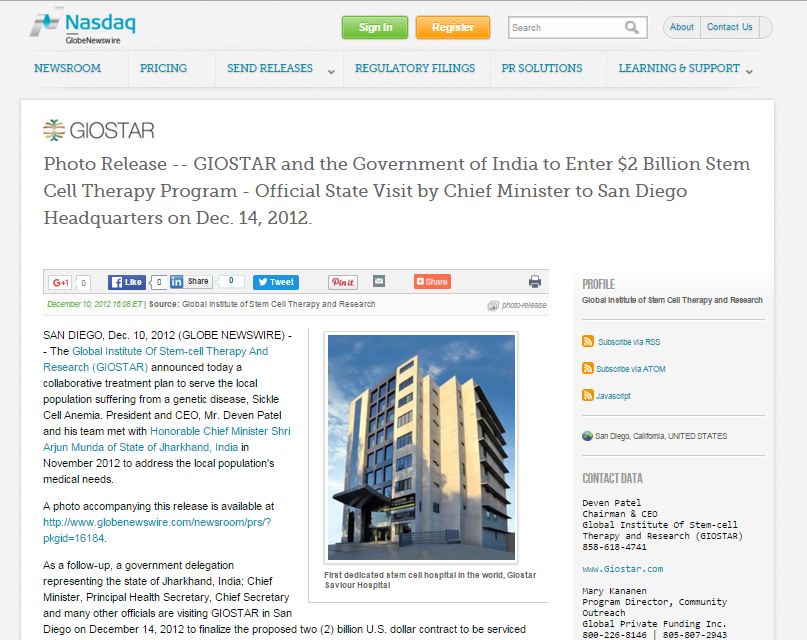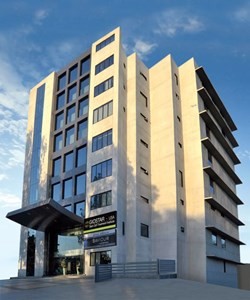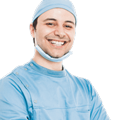Therapeutic potential of mesenchymal stem cells in regenerative medicine
Therapeutic potential of mesenchymal stem cells in regenerative medicine
Devang M. Patel, 1 Jainy Shah, 1 and Anand S. Srivastava 2 ,*
Abstract
Mesenchymal stem cells (MSCs) are stromal cells that have the ability to self-renew and also exhibit multilineage differentiation into both mesenchymal and nonmesenchymal lineages. The intrinsic properties of these cells make them an attractive candidate for clinical applications. MSCs are of keen interest because they can be isolated from a small aspirate of bone marrow or adipose tissues and can be easily expanded in vitro. Moreover, their ability to modulate immune responses makes them an even more attractive candidate for regenerative medicine as allogeneic transplant of these cells is feasible without a substantial risk of immune rejection. MSCs secrete various immunomodulatory molecules which provide a regenerative microenvironment for a variety of injured tissues or organ to limit the damage and to increase self-regulated tissue regeneration. Autologous/allogeneic MSCs delivered via the bloodstream augment the titers of MSCs that are drawn to sites of tissue injury and can accelerate the tissue repair process. MSCs are currently being tested for their potential use in cell and gene therapy for a number of human debilitating diseases and genetic disorders. This paper summarizes the current clinical and nonclinical data for the use of MSCs in tissue repair and potential therapeutic role in various diseases.
1. Introduction
Stem cells are immature tissue precursor cells which are able to self-renew and differentiate into multiple cell lineages [1, 2]. Mesenchymal stem cells (MSCs), also known as multipotent mesenchymal stromal cells, are self-renewing cells which can be found in almost all postnatal organs and tissues [3, 4]. MSCs have received wider attention because they can be easily isolated from a small aspirate of bone marrow or adipose tissue and can be expanded to clinical scales in in vitro condition. Other than these MSCs offer several other advantages like long-term storage without major loss of potency and no adverse reactions to allogeneic MSCs transplant [5].
In 1976 Friedenstein et al. firstly described a method for MSCs (referred as “stromal cells”) isolation from whole bone marrow aspirates based on differential adhesion properties. They suggested that these cells are adherent, clonogenic, nonphagocytic, and fibroblastic in nature, with the ability to give rise to colony forming units-fibroblastic (CFU-F) [6]. In late 1980s Owen and Friedenstein reported heterogeneity of the bone marrow stromal cells for the first time [7, 8]. Bone marrow stromal cells were further characterized and named mesenchymal stem cell to describe the subtype of marrow stromal cells involved in the process of mesengenesis [9, 10]. Shortly after these discoveries researchers started to explore the therapeutic application of MSCs [11], since then no adverse effect of MSC transplantation has been reported. In this paper we tried to compile recent advances in the MSCs research and its medical implications.
2. Immunophenotype of MSC
The identification of MSCs with the use of specific markers remains elusive. There is no single surface marker, but rather a panel of surface markers which define Human MSCs (hMSCs), derived from fresh tissues or cryopreserved samples. As per the international society for cellular therapy guidelines, MSCs must express CD105 (SH2), CD73 (SH3/4), and CD90 and must be negative for surface markers CD34, CD45, CD14, CD79α or CD19, and HLA-DR [9]. hMSCs are also negative for several other antigens like CD4, CD8, CD11a, CD14, CD15, CD16, CD25, CD31, CD33, CD49b, CD49d, CD49f, CD50, CD62E, CD62L, CD62P, CD80, CD86, CD106 (vascular cell adhesion molecule [VCAM]-1), CD117, cadherin V, and glycophorin A. On the other hand, hMSCs are positive for CD10, CD13, CD29 (b1-integrin), CD44, CD49e (a5-integrin), CD54 (intercellular adhesion molecule [ICAM]-1), CD58, CD71, CD146, CD166 (activated leukocyte cell adhesion molecule [ALCAM]), CD271, vimentin, cytokeratin (CK) 8, CK-18, nestin, and von Willebrand factor [5, 12, 13]. Tissue specific expression of surface marker is well noted such as only adipose tissue-derived MSCs express high levels of CD34 [14] and bone-marrow-derived MSCs, but not placenta derived MSCs, express CD271 [15]. Detailed phenotypic expression of surface markers is reviewed elsewhere [16].
3. Differentiation Potential of MSC
Other than surface markers MSCs must have ability to adhere to plastic and differentiate into osteoblasts, adipocytes, and chondroblasts under in vitro condition [9]. Differentiation is regulated by genetic events, involving transcription factors. Differentiation to a particular phenotype pathway can be controlled by some regulatory genes which can induce progenitor cells’ differentiation to a specific lineage. Besides growth factors and induction chemicals, a microenvironment built with biomaterial scaffolds can also provide MSCs with appropriate proliferation and differentiation conditions [17]. Even though MSCs can differentiate into a number of tissues in vitro, the resulting cell population does not mimic the targeted tissues entirely in their biochemical and biomechanical properties [18].
3.1. Mesoderm Differentiation
Theoretically, mesodermal differentiation is easily attainable for MSCs because they are from same embryonic origin. In the literature also mesoderm (osteogenic, adipogenic, and chondrogenic) differentiation is relatively well studied. A mixture of Dexamethasone (Dex), β-glycerophosphate (β-GP), and ascorbic acid phosphate (aP) has been widely used for induction in osteogenic differentiation [18, 19]. Osteogenic differentiation of MSCs is a complex process that is tightly controlled by numerous signaling pathways and transcription factors [20]. Runt-related transcription factor 2 (Runx2) and Caveolin-1 are considered a key regulator of osteogenic differentiation which is precisely regulated by numerous activators and repressors [19–21]. Bone morphogenetic proteins (BMPs), especially BMP-2, BMP-6, and BMP-9, have been shown to enhance osteogenic differentiation of MSCs [18]. Smads, p38 and Extracellular signal-Regulated Kinase-1/2 (ERK1/2) are involved in BMP9-induced osteogenic differentiation [22]. At very low concentration BMP-2, vascular endothelial growth factor (VEGF) and basic fibroblast growth factor (bFGF) synergistically promote the osteogenic differentiation of rat bone marrow-derived mesenchymal stem cells. Other than core binding factor alpha-1/osteoblast-specific factor-2 (cbfa1/osf2) [23], Wnt signaling has also been implicated in osteogenic differentiation of MSCs [24]. Recently a study by Alm et al. showed that transient 100 nM dexamethasone treatment reduces inter- and intraindividual variations in osteoblastic differentiation of bone marrow-derived human MSCs [25]. An alternative approach would be to use a scaffold or matrix engineered to provide cues for differentiation. Silicate-substituted calcium phosphate (Si-CaP) supported attachment and proliferation of MSCs was proved to be osteogenesis [26]. In adipogenesis differentiation, Dex and isobutyl-methylxanthine (IBMX) and indomethacin (IM) have been used for induction and have been observed by staining the lipid droplets in cells by Oil Red O solution. Peroxisome proliferator-activated receptors-γ2 (PPAR-γ2), CCAAT/enhancer binding protein (C/EBP), and retinoic C receptor have been implicated in adipogenesis [17]. Phosphatidylinositol 3-kinase (PI3 K) activated by Epac leads to the activation of protein kinase B (PKB)/cAMP response element-binding protein (CREB) signaling and the upregulation of PPARγexpression, which in turn activate the transcription of adipogenic genes, whereas osteogenesis is driven by Rho/focal adhesion kinase (FAK)/mitogen-activated protein kinase kinase (MEK)/ERK/Runx2 signaling, which can be inhibited by Epac via PI3 K [27].
In chondrogenesis differentiation, transforming growth factor (TGF)-β1 and TGF-β2 are reported to be involved [28]. Differentiation of MSCs into cartilage is characterized by upregulation of cartilage specific genes, collagen type II, IX, aggrecan, and biosynthesis of collagen and proteoglycans. The emerging results suggested the possible roles of Wnt/β-catenin in determining differentiation commitment of mesenchymal cells between osteogenesis and chondrogenesis [19]. A recent report suggested that miR-449a regulates the chondrogenesis of human MSCs through direct targeting of Lymphoid Enhancer-Binding Factor-1 [29]. Elevated β-catenin signaling induces Runx2, resulting in osteoblast differentiation, whereas reduced β-catenin signaling has the opposite effect on gene expression, inducing chondrogenesis [30]. Fibroblasic Growth factor-2 (FGF-2) can enhance the kinetics of MSC chondrogenesis, leading to early differentiation, possibly by a priming mechanism [31].
3.2. Ectoderm Differentiation
In vitro neuronal differentiation of MSCs can be induced by DMSO, butylated hydroxyanisole (BHA), β-mercaptoethanol, KCL, forskolin, and hydrocortisone [17]. Moreover, Notch-1 and protein kinase A (PKA) pathways are found to be involved in neuronal differentiation [32]. In presence of other stimulatory, downregulation of caveolin-1 promotes the neuronal differentiation of MSCs by modulating the Notch signaling pathway [33].
3.3. Endoderm Differentiation
In liver differentiation, hepatocyte growth factor and oncostatin M were used for induction to obtain cuboid cells which expressed appropriate markers (α-fetoprotein, glucose 6-phosphatase, tyrosine aminotransferase, and CK-18) and albumin production in vitro [34]. Recent studies identified methods to develop pancreatic islet β-cell differentiation from adult stem cells with desirable results. The resulting cells showed specific morphology, high insulin-1 mRNA content, and synthesis of insulin and nestin [35, 36]. Murine adipose tissue-derived mesenchymal stem cells can also differentiate to endoderm islet cells (expressing Sox17, Foxa2, GATA-4, and CK-19) with high efficiency then to pancreatic endoderm (Pancreatic and duodenal homeobox 1[Pdx-1], Ngn2, Neurogenic differentiation [NeuroD], paired box-4 [PAX4], and Glut-2), and finally to pancreatic hormone-expressing (insulin, glucagon, and somatostatin) cells [37].
4. Migration and Homing
The physical niche and migration signals of MSCs provide invaluable information about their role and interactions within the tissue. Bone-marrow-derived MSCs received more attention from researchers in hopes of revealing clues about their therapeutic activity. During in vivo condition, it is difficult to locate MSCs’ niche. Moreover due to the lack of any specific MSCs marker and difficulties in probing marrow cavities, it is very difficult to track dynamic movement of MSC. Most researchers use genetic markers such as Y-chromosome, when male cells are introduced into females or fluorescent protein reporter genes but these methods do not resolve the dynamics of cellular and temporal responses and are not quantitative [5]. Noninvasive in vivo imaging accomplished by using bioluminescence imaging (BLI) can be a possible solution. The main advantage of BLI is that even at very low levels of signal, as few as 100 cells can be detected in vivo [38, 39]. Significant advances have been made in this field but still MSCs migration to tissue niche is illusive.
MSCs migration to injured tissues has been reported in radiation-induced multiorgan failure, ischemic brain injury, myocardial infarction, and acute renal failure [40], but the mechanisms that regulate the MSCs migration to the injured tissues are still unknown. Human MSCs express different combinations of the chemokine receptors CCR1, CCR4, CCR7, CCR9, CCR10, CXCR1, CXCR3, CXCR4, CXCR5, and CX3CR1 [41]. The chemokine(s) that control MSCs trafficking are still unknown; while to date, 39 chemokines have been identified with different functions controlling the traffic of hematopoietic cells, in particular leukocytes [41]. Among these chemokines, stromal cell derived factor-1 (SDF-1) is relatively well studied for MSCs migration.
SDF-1-induced cell migration is mediated by its receptor, CXCR4, which is broadly expressed in cells of the immune system and in the central nervous system (CNS). The role of SDF-1 as an important mediator of stromal progenitor migration to injured tissue has been reported in vivo using a rat model of myocardial infarction [42, 43]. Hiasa et al., 2004 reported that the overexpression of human SDF-1 in the ischemic muscle induced the mobilization of endothelial progenitor cells and improved myocardial healing. Studies also demonstrated that after myocardial infarction the levels of SDF-1 are increased in infarcted tissue and this increase correlates with the number of MSCs that home into the heart [42, 43]. On the other hand, study by Ip et al., 2007 suggested that MSCs use integrin β1 and not CXCR4 for their myocardial migration [44]. Moreover, in regenerating skeletal tissues, the MSCs homing may be improved with growth factor delivery, as combined MSCs and erythropoietin infusion gave better results in limb ischemia treatment [45]. Bioactive lipid lysophosphatidic acid (LPA) plays a principal role in the migration of human lung resident MSCs through a signaling pathway involving LPA1-induced beta-catenin activation [46]. Anti-inflammatory environment is more accommodating to the therapeutic hMSCs than a proinflammatory environment [47].
Crossing of the endothelial barrier is another critical step for the tissue migration of circulating cells. Similarly to leukocytes, MSCs adhesion to the endothelial cells represents a critical step and a restricted set of molecules such as selectin-P, integrin β1, and VCAM-1 and seems to play critical roles in this interaction [48]. The in vivo homing potential of MSCs circulating in the bloodstream to the sites of injury/inflammation can be regulated by adhesion of MSCs to endothelium, achieved by pretreatment of endothelial cells with some proapoptotic agents, angiogenic and inflammatory cytokines, and growth factors, such as interleukin (IL)-8, neurotrophin-3, TGF-β, IL-1β, TNF-α, platelet-derived growth factor, EGF, and SDF-1 [12]. Further studies into understanding the molecular mechanism behind migration and homing will provide an impetus to the use of MSCs for therapeutic purpose.
5. Mechanism of Action/Mode of Action
The mechanism by which MSCs exert their antiproliferative effect have still to be fully elucidated, although several mechanisms and molecules have been proposed that are likely to act in concert and/or in alternate fashion depending on the environment conditions to which MSCs are exposed. Several studies have shown that MSCs are capable of replacing damaged tissues in vivo [49, 50]. Multiple tissue engineering approaches have also been reported where undifferentiated or predifferentiated MSCs were delivered with or without help of biomaterial [49, 50]. MSCs have shown promise in replacing various tissues including cartilage, bone, tendon, vasculature, liver kidney, and nerve [51]. However, it remains unclear that how many originally delivered MSCs retain residency in the wounded tissue and maintain the appropriate terminally differentiated phenotype because large amount of transplanted population become apoptotic within the initial phase, or migrate to lungs and liver. Study on stroke and cardiac injury by Li et al. and Askari et al., respectively, suggested that transient MSCs presence appears to be sufficient to elicit a therapeutic effect [52, 53]. Taking together these findings suggests that resident MSCs also work to suppress both transient and perpetual immune surveillance systems and create an ideal healing environment by secreting factors and altering the local microenvironment [51].
Since 2002 in vitro T-lymphocyte activation and proliferation assays have been used in several studies which resulted in understanding the immunomodulatory effect of MSCs from human, murine, and baboon [54–56]. These studies demonstrated that MSCs were capable of suppressing both lymphocyte proliferation and activation in response to allogeneic antigens. Moreover, MSCs can induce development of CD8+regulatory T (Treg) cells than can in turn successfully suppress allogeneic lymphocyte responses [56] and prohibit differentiation of monocytes and CD34+ progenitors into antigen presenting dendritic cells [57]. T cells stimulated in presence of MSCs get arrested in the G1 phase as a result of cyclin D2 downregulation [58]. MSCs are also capable of inhibiting the proliferation of IL-2 or IL-15 stimulated NK cells [59, 60]. MSCs have also been shown to alter B-cell proliferation, activation, IgG secretion, differentiation, antibody production, and chemotactic behaviors [51]. Treatment with in vitro expanded allogeneic MSCs successfully resolved severe grade IV acute graft-versus host disease (GvHD) supported in vivo immunomodulatory properties of MSCs [61]. Furthermore, MSCs reduce expression of major histocompatibility complex class II (MHCII), CD40, and CD86 on Dendritic cell (DC) following maturation induction [51]. Interestingly, allogeneic MSCs which were differentiated towards a chondrogenic phenotype continued to suppress antigen specific T-cell proliferation in rheumatoid arthritis [62] and genetically engineered MSCs escaped immune rejection and induced ectopic bone formation in vivo [56]. However several other reports suggested that the immunomodulatory effects of MSCs are not universal and unconditional and that the MSCs phenotype is transient and context dependent [63].
Cytokine secretion is one of the major therapeutic characteristics of MSCs [64]. MSCs secretion is not limited to factors like TGF-β, IL-10, IL-6, cyclooxygenase-1 (COX-1), and COX-2 which are responsible for prostaglandin E2 (PEG2) secretion. MSCs partly inhibited DC differentiation through IL-6 secretion and reduced tissue inflammation by IL-10, TGF-β1, and IL-6 secretion [57, 65]. TGF-β1 secretion by MSCs suppresses T-lymphocyte proliferation and activation, initiated by IL-1β secretion from CD14+monocytes [66]. In fact one study suggested that only the supernatants obtained from cocultures of stromal cells and activated T cells displayed an immunosuppressive effect when added to secondary cultures of proliferating T cells [58, 67]. Taking together MSCs mediated immunosuppression is not exclusively the result of a direct inhibitory effect but involves the recruitment of other regulatory effects. Details about immune-modulation of immune response are reviewed elsewhere [68, 69].
Read More : Click Here








